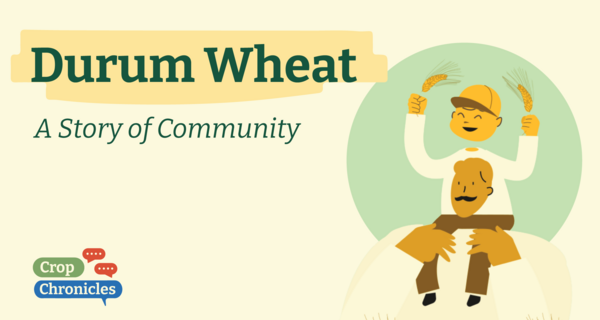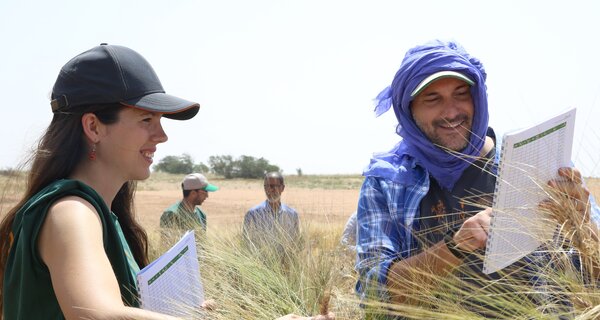Durum Wheat: The Best Kept Secret in Katie Parla’s Pasta

26 July 2024
Durum wheat is the behind-the-scenes star of the culinary world. Sure, it's used in all sorts of dishes globally, from North African couscous to Middle Eastern bulgur, but pasta? That's where durum wheat truly shines. Pasta, with its endless shapes and varieties, is probably the most famous use of this hard, protein-rich grain, especially in Italian cuisine. It’s the ultimate comfort food that unites people of all ages – including our most picky eaters, toddlers.
Pasta has been around for ages. Some say the Etruscans – a civilization that inhabited central-western Italy, between Lazio and Tuscany, from the 9th century B.C. – were the first to whip up a form of pasta using spelt flour and water. Fast forward to ancient Rome, and you'll find "lagana," an early version of layered pasta.
Durum wheat is key here. Its high protein and gluten content make it perfect for pasta, giving it that firm texture and that perfect al dente bite. This variety of wheat likely made its way from the Middle East to Italy through ancient trade routes, setting the stage for pasta's rise to fame.
By the Middle Ages, pasta had spread across the Mediterranean. The 13th century saw dried pasta, made from durum wheat semolina, becoming a pantry staple. Its long shelf life was a game-changer, especially for sailors and traders.
And let’s clear up a common myth: Marco Polo did not bring pasta to Italy from China. Pasta was already a thing in Italy long before Marco's travels. The real pasta revolution happened during the 19th-century industrial boom, when machines took over the kneading and shaping processes, making mass production possible.
Nowadays, pasta is a global sensation. From spaghetti and lasagna to ravioli and tortellini, it’s a versatile and beloved food in countless cultures. And through it all, durum wheat remains the star ingredient, ensuring that pasta keeps its unique quality and texture.

Photo courtesy of Katie Parla
Why not celebrate durum wheat with a dish of Sardinian cavatelli? Katie Parla, an acclaimed author, publisher, television and podcast host, journalist, culinary guide, and educator based in Rome has shared a tempting recipe from her latest cookbook Food of the Italian Islands: Malloreddus, also known as gnocchetti sardi, or Sardinian cavatelli.
Sardinian cavatelli
Makes 600 grams of pasta, to serve 6 to 8
Ingredients:
- 400 grams finely milled semolina flour (farina di semola rimacinata), plus more for dusting
- 200 grams very warm water (120°F or 48.8 °C)
Instructions:
Pour the fine semolina onto a work surface and make a large well in the middle. Add the water to the well, then mix with a fork, working from the edges of the well into the center, gradually incorporating the semolina to form a shaggy dough.
Knead the dough energetically just until there are no dry bits, about 5 minutes. The dough doesn’t need to be a smooth, compact mass. Wrap the dough in plastic wrap and allow it to rest at room temperature for 25 minutes.
Unwrap the dough and knead again until the dough is a smooth, compact mass, about 30 seconds. The dough will be fairly stiff. Wrap the dough in plastic wrap and allow it to rest at room temperature for 25 minutes more before shaping.
To shape, cut off a walnut-size piece of dough, keeping the rest covered. Roll the piece of dough into a long strand about the thickness of a pencil, then pull off a piece about ¼-inch (0.6cm) wide. Using the tip of your index finger, press and drag one piece of dough over a ridged surface or sushi mat toward your body. Set aside on a dry, clean wooden surface or a clean kitchen towel dusted with semolina. Repeat with the remaining dough. The pasta can sit out on the counter for up to 2 hours or it can be cooked right away. The shaped pasta can also be tightly wrapped in plastic wrap and frozen for up to a week.
To cook, bring a large pot of water to a rolling boil over high heat. Salt the water until it tastes like a seasoned soup. Add the pasta and cook until the raw bite is gone, about 3 minutes. Serve with a chunky meat or vegetable sauce.
Categories: For Educators, For The Press, For Students, Wheat, Food Security, Nutritional Security




